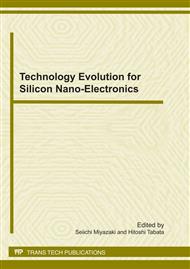p.129
p.135
p.140
p.146
p.152
p.158
p.164
p.171
p.175
Improved Electrical Properties and Thermal Stability of GeON Gate Dielectrics Formed by Plasma Nitridation of Ultrathin Oxides on Ge(100)
Abstract:
We demonstrated the impact of plasma nitridation on thermally grown GeO2 for the purposes of obtaining high-quality germanium oxynitride (GeON) gate dielectrics. Physical characterizations revealed the formation of a nitrogen-rich surface layer on the ultrathin oxide, while keeping an abrupt GeO2/Ge interface without a transition layer. The thermal stability of the GeON layer was significantly improved over that of the pure oxide. We also found that although the GeO2 layer is vulnerable to air exposure, a nitrogen-rich layer suppresses electrical degradation and provides excellent insulating properties. Consequently, we were able to obtain Ge-MOS capacitors with GeON dielectrics of an equivalent oxide thickness (EOT) as small as 1.7 nm. Minimum interface state density (Dit) values of GeON/Ge structures, i.e., as low as 3 x 1011 cm-2eV-1, were successfully obtained for both the lower and upper halves of the bandgap.
Info:
Periodical:
Pages:
152-157
Citation:
Online since:
February 2011
Keywords:
Price:
Сopyright:
© 2011 Trans Tech Publications Ltd. All Rights Reserved
Share:
Citation:


